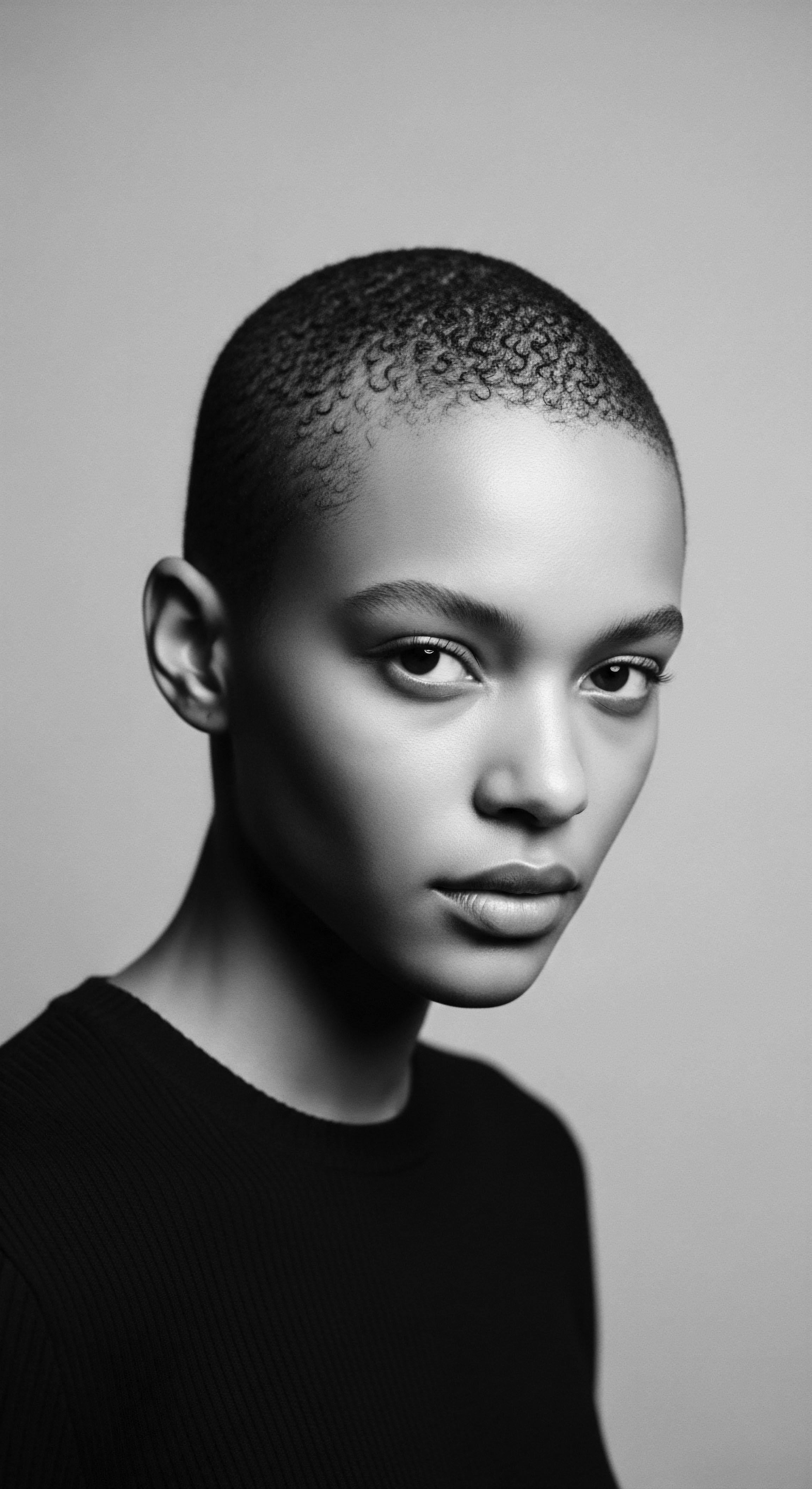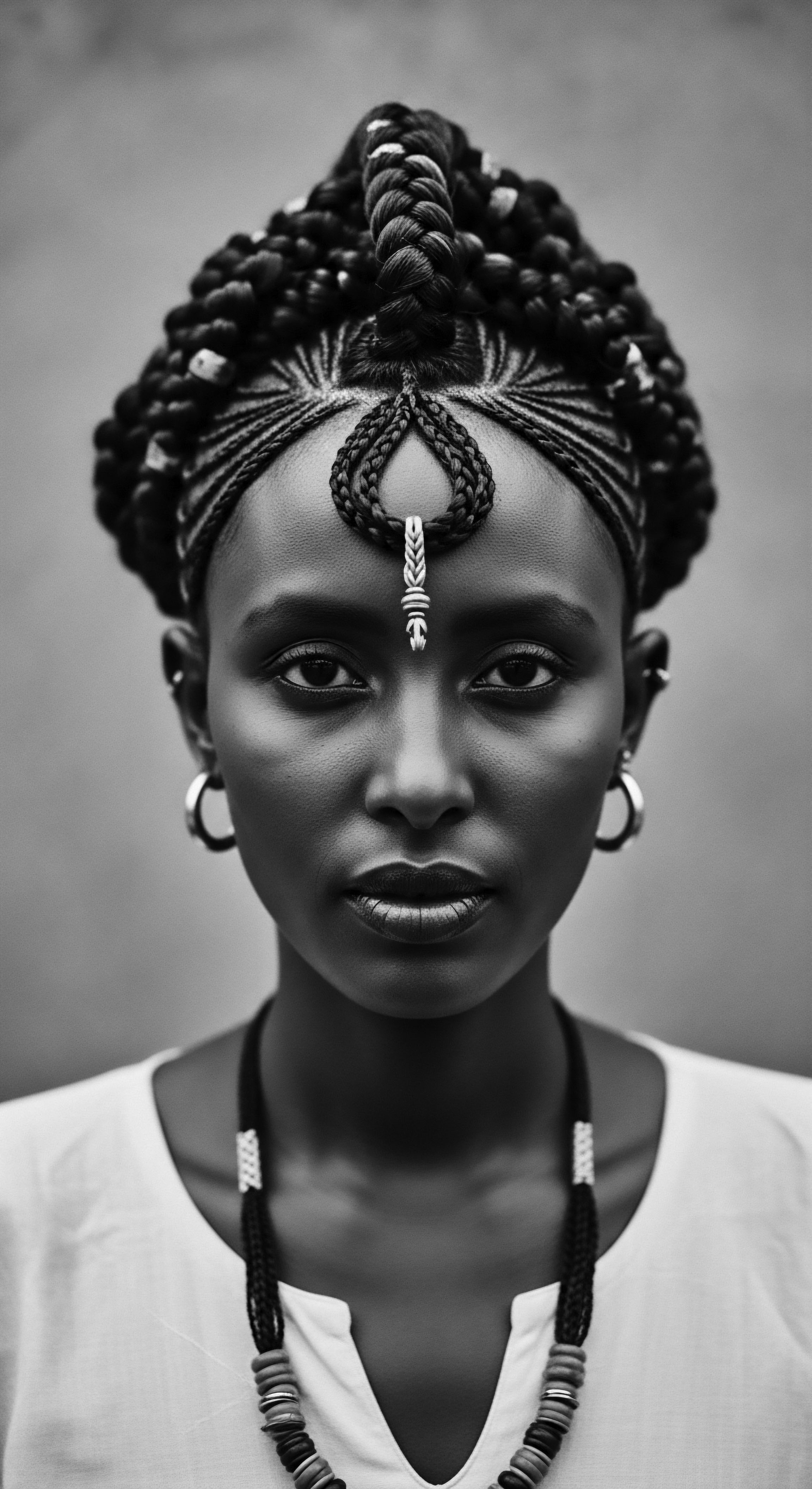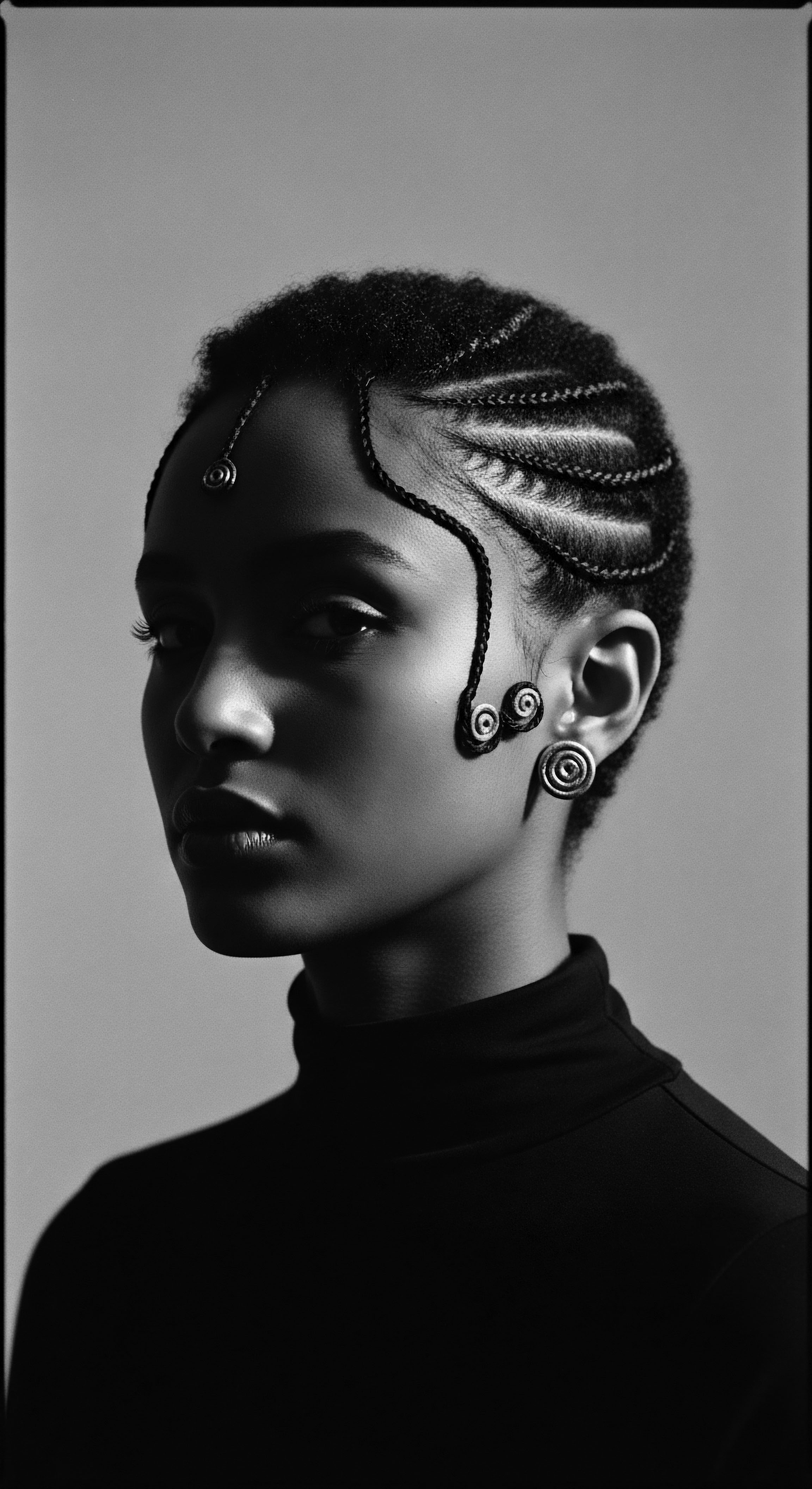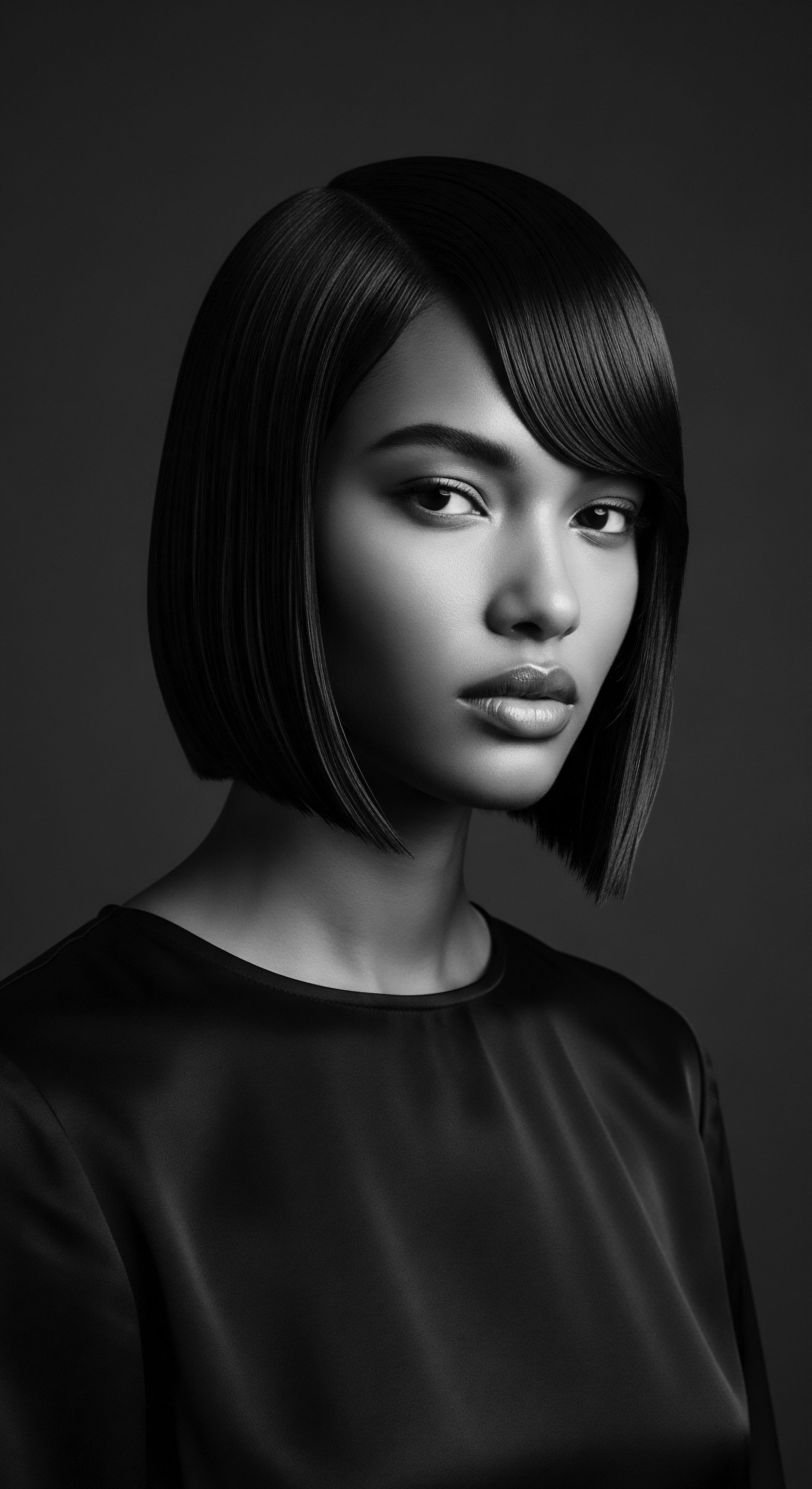
Roots
To truly understand the dialogue between ancient clay applications and contemporary textured hair care, we must first listen to the whispers of the earth itself, to the stories held within the very ground beneath our feet. For generations, long before the advent of modern laboratories and synthetic compounds, communities across the globe, particularly those with deep connections to the land, turned to natural elements for their grooming rituals. Among these elemental gifts, clay stands as a profound testament to ancestral wisdom, offering not merely a cleansing agent but a foundational understanding of hair’s holistic well-being. Its relevance today, particularly for textured hair, is not a rediscovery, but rather a re-affirmation of truths passed down through time, truths rooted in the unique heritage of hair.

Hair Anatomy and Textured Hair’s Ancestral Form
The intricate architecture of textured hair, with its coils, curls, and waves, possesses a biological makeup that is both resilient and delicate. From an ancestral perspective, this structure was revered, understood as a conduit of spiritual power, a marker of identity, and a crown of beauty. Ancient traditions recognized that this hair type, unlike straight hair, often required gentler cleansing and robust conditioning to maintain its health and vibrancy.
Clays, in their natural state, offer a cleansing action without stripping the hair of its precious natural oils, a characteristic deeply appreciated in traditional practices. This gentle yet effective cleansing property aligns perfectly with the needs of coily and curly strands, whose unique helical shape makes them prone to dryness and breakage if harsh detergents are employed.
The very composition of clay, rich in minerals such as Silica, Magnesium, and Calcium, provided a natural bounty for hair. These minerals, in their raw form, contributed to the hair’s strength, elasticity, and scalp health, echoing the modern scientific understanding of mineral importance in follicular wellness. We learn from these ancient practices that the interaction of elemental biology with care traditions shaped the very understanding of what healthy hair meant within a community.
Ancient clay applications offer a profound, heritage-rich lens through which to understand the unique biological and care needs of textured hair, echoing ancestral wisdom in modern practices.

Language of Textured Hair and Traditional Nomenclature
Our contemporary lexicon for textured hair, while increasingly rich, often finds its echoes in traditional terms and cultural understandings of hair’s nature. Beyond simple classifications, ancestral communities often used descriptive language for hair textures and their care needs, directly informing how they interacted with natural substances like clay. For instance, the very word for one of the most celebrated clays, Rhassoul (also spelled Ghassoul), originates from the Arabic word ‘rhassala,’ which translates to “to wash.” This linguistic root alone speaks volumes about its longstanding and primary application as a cleansing agent for both hair and skin in North Africa.
When considering traditional hair care, one finds that the approach was always holistic, connecting the physical aspects of hair to its spiritual and communal significance. Clay was not merely a substance; it was an ingredient that participated in a larger ritual of self-care and communal bonding. The ancient Egyptians, for example, incorporated clay into their haircare routines, often mixing it with oils and beeswax to create cleansing and styling preparations.
The understanding of hair growth cycles, while not formalized in ancient times with scientific terminology, was certainly observed. Factors such as diet, environment, and even spiritual well-being were understood to influence hair’s vitality. The seasonal availability of specific clays or other natural ingredients also dictated practices, reinforcing a deep connection to the rhythms of the earth. These ancestral observations laid the groundwork for a comprehensive understanding of hair’s needs, passed down through generations.

Ritual
The journey of clay from earth to hair was never a casual act; it was a ritual, imbued with intention, community, and an intuitive understanding of the earth’s offerings. These practices, honed over centuries, reveal how ancient clay applications influenced and shaped a broad spectrum of traditional and modern styling heritage for textured hair. We find a continuity, a silent conversation between the past and the present, in the ways these earth-gifts are still revered for their ability to cleanse, condition, and prepare hair for its diverse expressions.

Ancestral Roots of Protective Hair Styling
Protective styling, a cornerstone of contemporary textured hair care, possesses ancestral roots that stretch back millennia. Many ancient African communities developed intricate braiding and coiling techniques not only for aesthetic appeal but also to shield hair from environmental elements and to facilitate its growth. In these settings, clay often served as a preparatory and finishing agent. It was used to cleanse the scalp before elaborate styles were set, ensuring a clean foundation.
Certain clays, like Red Ocher Clay, were mixed with fats and pigments and applied to hair as a protective coating, particularly by groups such as the Himba Tribe of Southwest Africa. This mixture not only protected the hair from sun and dryness but also imparted a distinctive color and a sense of cultural identity.
The application of clay before styling aided in managing the hair’s natural texture, providing a subtle hold and reducing frizz, which allowed for the creation of durable, complex styles. The minerals in the clay also contributed to the hair’s overall health during long periods of protective styling. These historical approaches offer powerful lessons on how to prepare and maintain textured hair with natural compounds, preserving its integrity for enduring styles.

Traditional Natural Hair Definition Techniques
For centuries, the quest for defined coils and curls relied on natural ingredients that worked in harmony with the hair’s inherent structure. Clays, especially those with strong absorbent and drawing capacities, were integral to these methods. When hydrated, clays form a slippery, gelatinous paste that can coat hair strands, helping to clump curls and reduce shrinkage.
This natural property aids in defining textured patterns, a sought-after effect in many contemporary natural hair routines. The traditional use of these clays, often combined with water or herbal infusions, allowed for gentle cleansing that preserved the hair’s natural moisture balance, a critical factor for maintaining curl definition.
Consider the use of Bentonite Clay. When mixed with water, it develops a negative electrical charge that attracts positively charged impurities, dirt, and product buildup from the hair. This cleansing action removes unwanted elements without stripping the natural oils that textured hair requires, thereby enhancing natural curl patterns and softness. Its application was not about altering the hair’s fundamental nature but about amplifying its inherent beauty.
| Clay Type Rhassoul Clay (Ghassoul) |
| Historical Use (Heritage Context) Used for thousands of years by Berber women in North Africa as a shampoo and conditioner, known for gentle cleansing and softening. |
| Contemporary Application (Informing Care) Employed in modern "no-poo" routines and hair masks for gentle cleansing, scalp detoxification, and enhancing curl definition. |
| Clay Type Bentonite Clay |
| Historical Use (Heritage Context) Used traditionally in Iran and other regions as a hair cleanser and softener, valued for drawing out impurities. |
| Contemporary Application (Informing Care) Found in detox masks and clarifying treatments for deeply cleansing the scalp, removing product buildup, and promoting softer hair. |
| Clay Type Kaolin Clay |
| Historical Use (Heritage Context) Used in various cosmetic preparations, including hair, for its mild cleansing and oil-absorbing properties, suitable for sensitive scalps. |
| Contemporary Application (Informing Care) Integrated into gentle shampoos and conditioners for dry or sensitive scalps, offering mild cleansing and oil absorption without stripping. |
| Clay Type These clays, once cornerstones of ancestral hair care, continue to shape our understanding of holistic cleansing and natural hair health. |

What are the Cultural Meanings Intertwined with Ancient Hair Care Practices Involving Clay?
The cultural meanings intertwined with ancient hair care practices involving clay extend far beyond mere cleanliness. Hair, particularly within Black and mixed-race heritage, has always served as a potent symbol of identity, status, spirituality, and community. The use of clay in these practices was therefore layered with significance. For many African communities, the communal act of hair grooming, which often involved applying natural substances like clay, served as a vital social occasion for bonding, knowledge transfer, and the reinforcement of familial ties.
For the Himba people of Namibia, for example, a paste called ‘otjize,’ made of Ocher Clay, Butterfat, and sometimes herbs, is applied to their skin and hair. This practice is not just for beauty or protection; it is deeply ceremonial, signifying age, marital status, and a connection to their ancestral lands. The distinctive reddish hue of their hair, achieved through this clay application, is a visual marker of their cultural identity and enduring heritage. This practice speaks to a deliberate choice, where natural elements are consciously chosen to reflect a people’s spiritual connection to their environment and their ancestors.
Similarly, in some Indigenous American traditions, natural materials like clay and yucca root were used to purify hair, reflecting a profound respect for hair as a spiritual extension of the self. These practices were rooted in a deep understanding of nature’s offerings and a reverence for hair’s role in conveying personal and cultural symbols. The presence of clay in these ancient rituals highlights its role as a sacred ingredient, connecting individuals to their ancestral lands and a broader sense of self that transcends mere physical appearance.
The transfer of these applications, from ancient use to modern interest, represents a renewed appreciation for these deeper cultural meanings. It is a recognition that true hair wellness involves not only scientific understanding but also a profound respect for the historical and cultural contexts that have shaped hair practices across generations.

Relay
The current appreciation for ancient clay applications in textured hair care is not merely a nostalgic return to the past. It represents a sophisticated relay of ancestral wisdom, refined by modern scientific understanding, to serve the unique needs of contemporary Black and mixed-race communities. This bridge between historical practice and scientific inquiry offers a profound understanding of why these earth-derived compounds remain highly relevant in our holistic care regimens. We are observing the validation of long-standing traditional knowledge through the lens of current understanding, creating a more robust and heritage-informed approach to hair wellness.

Building Personalized Textured Hair Regimens with Ancient Wisdom
Crafting a regimen for textured hair requires a nuanced approach, often inspired by the adaptability seen in ancestral practices. Ancient communities did not rely on a single, universal solution; instead, they customized their hair care based on local resources, individual hair types, and environmental factors. This customization often involved specific types of clay, chosen for their distinct properties. For instance, while Rhassoul Clay was widely used in North Africa for its cleansing and conditioning attributes, other regions might have favored different clays with varied mineral compositions, such as Kaolin for its gentleness or Bentonite for its stronger absorption.
Modern science now illuminates the specific mechanisms behind these historically observed benefits. For example, the high cation exchange capacity of certain clays, such as smectites (which include Bentonite and Montmorillonite), explains their ability to absorb impurities and toxins from the hair and scalp while leaving essential moisture intact. This scientific explanation validates the anecdotal evidence passed down through generations, empowering individuals to select clays that truly align with their hair’s porosity, oil production, and sensitivity.
The practice of “no-poo” or low-poo washing, where traditional shampoos are replaced or supplemented with natural cleansers, directly echoes ancient traditions of using clay as a primary washing agent. This methodology, long practiced in communities that valued preserving hair’s natural oils, is now gaining traction as a science-backed method for maintaining healthy hair without stripping it of its inherent protective lipid barrier.

Why are Clays a Good Alternative for Contemporary Textured Hair Cleansing?
Clays offer a compelling alternative for cleansing textured hair today due to their unique biophysical properties that mirror the gentle yet effective cleansing needs of curls and coils. Unlike many conventional shampoos that rely on harsh sulfates to create lather and strip oils, clays operate differently. When mixed with water, clay particles possess a negative electromagnetic charge that attracts positively charged impurities, dirt, and excess sebum from the hair and scalp. This drawing action allows for deep cleansing without disturbing the hair’s natural moisture balance, a critical aspect for maintaining the integrity and hydration of textured strands.
Moreover, clays are rich in beneficial minerals that can nourish the scalp and hair, contributing to overall hair health. Bentonite clay, for example, is composed of minerals like Silica, Magnesium, and Calcium, which are known to strengthen hair shafts and soothe irritated scalps. This mineral transfer to the hair and scalp during a clay wash or mask provides a conditioning effect that many textured hair types require. The gentle exfoliation provided by the fine particles of clay also helps to remove dead skin cells from the scalp, fostering a healthier environment for hair growth.
Here are some of the minerals commonly found in cosmetic clays and their relevance:
- Silica ❉ Contributes to hair shaft strength and elasticity, helping to prevent breakage.
- Magnesium ❉ May soothe scalp irritation and promote a balanced environment for hair growth.
- Calcium ❉ Supports healthy hair growth and overall hair structure.
- Potassium ❉ Helps to balance scalp pH and moisture levels.
- Iron ❉ Can contribute to cell renewal and has antiseptic properties.

Traditional Nighttime Rituals and Their Modern Echoes
The concept of nighttime hair protection, now popularized by satin bonnets and silk pillowcases, has profound ancestral roots. In many Black and mixed-race communities, meticulous nighttime care rituals were essential for preserving elaborate hairstyles and protecting delicate hair strands. While specific records of clay use during sleep rituals are less common than its role in cleansing, the underlying principle of protecting hair from friction and moisture loss certainly aligns.
Ancient practices involved wrapping hair in cloths or using specific head coverings to maintain moisture, prevent tangling, and keep styles intact through the night. These coverings, often made from natural fibers, created a protective sanctuary for the hair, much like contemporary bonnets.
The wisdom of these nighttime preparations speaks to a deep understanding of textured hair’s vulnerability to dryness and mechanical damage. The moisture-retaining properties of clays, when used as leave-in treatments or rinses, would have contributed to the hair’s condition, making it more pliable and resilient for the next day’s styling. Today, the choice to use clays in pre-bedtime scalp treatments or gentle cleansing routines aligns with this ancestral foresight, ensuring hair remains protected and nourished even through rest.

Solving Textured Hair Challenges with Ancestral Clay Knowledge
Many common challenges faced by textured hair – from excessive dryness and frizz to scalp irritation and product buildup – found their remedies in ancient clay applications. For those struggling with oily scalps or significant product residue, the absorbent nature of clays, such as Bentonite or Fuller’s Earth, was a natural solution. These clays could effectively draw out excess oils and impurities, leaving the scalp clean and balanced without harsh stripping.
Conversely, for dry or brittle hair, certain clays like Rhassoul, when properly hydrated, act as gentle conditioners, improving elasticity and adding a natural softness without weighing hair down. This duality of action – cleansing for oily conditions, conditioning for dry – allowed ancestral practitioners to address a spectrum of hair needs with a single, versatile ingredient. The wisdom gathered from generations of working with these earth compounds provides a living compendium of solutions, proving that effective, gentle care has always been at our fingertips. This ancestral ingenuity informs contemporary formulations that seek to replicate clay’s beneficial properties for holistic hair health.
The history of hair care is replete with instances where natural elements were central to well-being. A fascinating case study emerges from the Himba People of Namibia, whose distinctive hair practices involve the regular application of ‘otjize,’ a paste of Red Ocher Clay, Butterfat, and sometimes aromatic resins. This blend serves not only as a cosmetic but also as a protective barrier against the harsh desert sun and dry climate. The application of otjize, often done daily by women, reflects a deep cultural connection to their environment and ancestors.
It signifies their tribal identity, marital status, and a profound reverence for their physical appearance as an extension of their spirit. This practice has been passed down through countless generations, exemplifying how a humble clay application can embody complex cultural narratives and provide sustained hair health in challenging conditions.

Reflection
The story of ancient clay applications in textured hair care is a profound meditation on the enduring legacy of ancestral wisdom. We observe how the elemental purity of the earth’s clays, once integral to the self-care rituals of our foremothers and forefathers, continues to resonate in our modern pursuit of hair wellness. This unbroken lineage reminds us that the quest for healthy, vibrant textured hair is not a fleeting trend, but a deeply rooted aspect of human heritage, particularly within Black and mixed-race communities. The very earth provides the tools for nurturing our crowns, offering lessons in balance, reverence, and patience that transcend time.
Just as a potter shapes clay with discerning hands, so too did our ancestors shape their understanding of hair, molding routines that honored its delicate nature and celebrated its unique patterns. The echoes from the source, the gentle touch of the tender thread of communal care, and the self-expression of the unbound helix all converge in this ongoing conversation with the past. Our contemporary engagement with clay for textured hair is a living archive, a continuous act of honoring the ingenuity that came before us.
It is a powerful affirmation that the deepest insights into hair health often lie not in the latest chemical compounds, but in the elemental connections forged across generations. We carry this ancestral wisdom forward, allowing it to guide our choices, shape our self-perception, and affirm the profound beauty of our hair’s inherited story.

References
- Agbabiaka, Olusegun. “The Legacy of Lathers ❉ Tracing the Historical Use of Natural Ingredients.” Herbal Haircare Journal, 2023.
- Alhousseini, Souad, and Pierre-Yves Chupin. “Clays in Cosmetics and Personal-Care Products.” Elements, vol. 15, no. 5, 2019, pp. 317-322.
- Aljundi, A. and A. Al-Hussaini. “Bentonite Clay ❉ A Review of its Chemical Properties and Therapeutic Uses.” Journal of Chemical and Pharmaceutical Research, vol. 8, no. 5, 2016, pp. 296-302.
- Bingo Cosmetic Manufacture Ltd. “The History of Hair Clay ❉ A Timeless Styling Tool.” Bingo Cosmetic Blog, 2024.
- Carr, Debra, and J. C. Green. “Cosmetic Clay in Hair Care.” Helenatur, 2019.
- Díaz, S. and R. Martínez. “The Scenario of Clays and Clay Minerals Use in Cosmetics/Dermocosmetics.” Minerals, vol. 12, no. 1, 2022, pp. 1-17.
- Hamid, Fatema. “Everything You Need to Know About Rhassoul Clay ❉ For Hair and Skin Detoxification!” Afro Hair Blog, 2019.
- Healthline. “How to Detox Your Hair of Oils, Dandruff, and Chemical Buildup.” Healthline, 2019.
- HeyCurls. “6 Amazing Bentonite Clay Hair Benefits & How To Use It.” HeyCurls Blog, 2021.
- Katherine Haircare. “Ultimate Historical Hair Care Guide | Straight, Curly & Kinky.” Katherine Haircare Blog, 2023.
- Lazar, L. “Bentonite Clay as a Natural Remedy ❉ A Brief Review.” Iranian Journal of Public Health, vol. 47, no. 12, 2018, pp. 1779-1785.
- MINATURE. “Benefits and Uses Of Moroccan Rhassoul Clay for Hair & Skin.” MINATURE Blog, 2024.
- Morrocco Method. “10 Easy DIY Home Remedies to Detox Your Hair.” Morrocco Method Blog, 2024.
- Native Hair Traditions. “Native Hair Traditions.” Notes From the Frontier, 2019.
- Rastta Locs. “Rhassoul Clay ❉ A Moroccan Treasure for Hair Health.” Rastta Locs Blog, 2024.
- Selix, Aisha. “A Brief History Of Black Hair Rituals.” ELLE UK, 2020.
- Soapy Twist. “Guide to Use Cosmetic Clays | DIY Skin & Hair Care.” Soapy Twist Blog, 2024.
- Timeless Beauty Secrets. “African Rare Clay Conditioning Softening & Nourishing Shampoo for Curly Frizzy Hair.” Timeless Beauty Secrets Blog, 2024.
- Vie, B. “What are the benefits of rhassoul clay?” BIOVIE Blog, 2024.
- Wellness Mama. “How to Detox Your Hair with Healing Clays & Mud.” Wellness Mama, 2014.
- Zahra, A. “Rhassoul ❉ a ritual for hair and skin care to purify and relax body and soul.” Cosmetica Italia, 2024.
